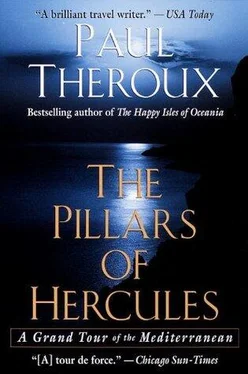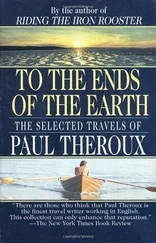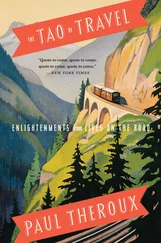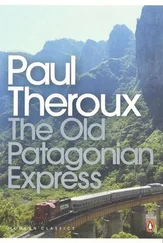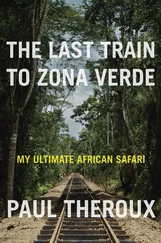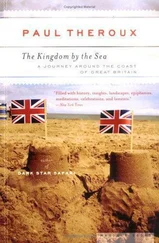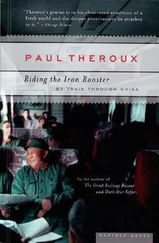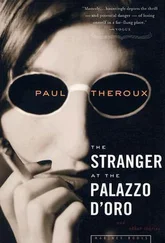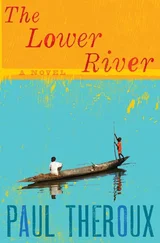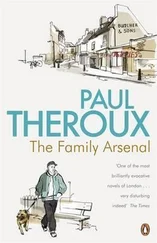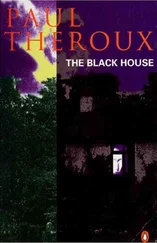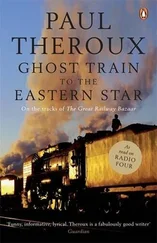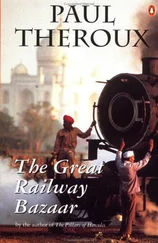This debased form of the corrida is not ancient; it dates from the late eighteenth century, with many gory modernisms. Yet elaborate cultural explanations are made on behalf of bullfighting. I found them all laughable, and the only satisfying part of a bullfight to me was seeing a gored matador lying in the sand being trampled flat by the bull’s hooves, the bull’s horns in the supine torero’s gut. It is what ought to happen to anyone who dares to torment an animal. It was a reminder of the ape and the tourist: This bull is cruel — when I stab him he tries to gore me.
Give it a chance, Spaniards told me. You will become an aficionado. “Somehow it was taken for granted that an American could not have aficion,” Hemingway writes in The Sun Also Rises. But his hero and alter ego Jake Barnes has “aficion” (enthusiasm), he proves it, he is loved for it. Spaniards buy him drinks! “We’re talking bulls,” Jake says, when he is invariably talking balls. The novel is a pretentious sermon on the nobility of the corrida , one bloody bull after another, and all the pedantry of bull fever. It is an example of how badly the novel fails that the blood and the physical cruelty of the bullfight are never touched upon. “We had that disturbed emotional feeling that always comes after a bullfight, and the feeling of elation that comes after a good bullfight.”
I went to bullfights in Málaga, in Lorca, in Barcelona. What perversity in the Spanish character demanded this sickening spectacle? You couldn’t blame Franco for this, although it must have been a tremendous safety valve for all the frustration of fascism. The corridas depressed me, and I was glad to abandon the effort. But the events were inescapable, always on television, constantly in the newspaper. Even the small provincial papers in Spain had a page or two devoted entirely to news of bullfights. The section is headed “Bulls” and it deals with local ferias and ones that are much farther afield. Cartagena was a modest-sized town up the coast. The Cartagena paper had reports of bullfights in Lorca nearby, in Murcia, farther away in Zaragoza, and in Lima, Peru.
Nearly all the matadors had nicknames: El Tato (The Kid), El Niño, El Balsiqueño, Niño de la Taurina, El Quilas. There was a popular matador called Jesulín de Ubrique. The reports were detailed, using the numerous terms that are applied in a bullfight for the movements of the matador, or the bull’s defensive maneuvers, or the disposition of the severed ears. All this for a staged hemorrhaging.
The Spaniards were well-mannered with one another, restrained, seldom aggressive, seldom drunk in public, and they were generally kind to their animals. The idea that as members of the European Community the Spaniards might have to curb their appetite for bull torturing just made them laugh. They also jeered at the thought that they might have to abandon the practice of what could only be termed “chicken-yanking”—riding on horseback and snatching a live chicken from a row that hung on a line.
“Spain must not give this image!” an animal rights poster announced, showing various cruelties to animals, and it included bullfighting. But for this Spanish organization, ADDA — the Association for the Defense and the Rights of Animals — it was all uphill. It was hard for me to imagine that Spain would ever get rid of this institutionalized sadism.
I took the train to Málaga. A Malagueno said to me, “Everything in Spain is expensive. Also we have no money. Also there is twenty percent unemployment.”
The man was direct and pleasant and unsentimental, and I realized that I had wandered so widely in poor, envious, demoralized places that I had become accustomed to surliness and delay. The promptness of Spanish life was unexpected. Buses and trains traveled on time. Spanish politeness made me take the people and their pastimes more seriously.
Málaga was proud, tidy, a city of substance, with a pleasant harbor and a busy port. Ferries here left for the Spanish toehold of Melilla in Morocco, trains for Granada. The university was not far from my hotel and so I had the impression of Málaga as a place with a youthful population.
It was all so familiar, though, not just the overlay of Europe — banks, post offices, telephones — but the fact that many aspects of Euro-culture had been inspired by America. On the cosmopolitan shores of the Mediterranean, our electronic modernity had been absorbed along with our crass popular culture. Communications were so efficient they left few opportunities for people to meet each other. There was nothing like a bad ride or a long wait to inspire friendship and get strangers talking. But the simplicity of these features of Spain meant that people traveled quickly, efficiently, in silence. Not long ago in Europe if you wanted to make anything except a local telephone call you went to the telephone exchange and filled out a form and waited to be directed to your booth. In the smallest village in Spain, France, Italy, Croatia, Greece, Turkey — everywhere in Mediterranean Europe except Albania — you can make a phone call from a public phone, using an access code. In the park in Málaga I stepped into a phone booth and called my brother Peter, who happened to be in Casablanca. The next day in Guadix, in the barren mountains beyond Granada, I called Honolulu from the phone on the wall in the local bar.
Who’s that singing in Spanish?
I was on my way in a bouncing bus via Almería and Cartagena to Alicante.
Just inland in the villages above Almería, there were cave dwellers: caves had been cut or enlarged in the rubbly biscuit-colored hills and house fronts fixed to the cave entrance. The slopes were devoid of trees. It was a land of so little rain, and of so few people, of such dust and emptiness, that it could have been the far west of the United States — Arizona or New Mexico. When I remarked on this to a Spaniard in Almería he told me that it had been the location for many of the Sergio Leone so-called spaghetti westerns.
Almost in sight of the overbuilt coast, this countryside was lovely in its grandeur and in its sunlight and emptiness, its white huts and grazing goats and olive groves, houses of stacked stone, some with grape arbors and others hung with garlands of drying red peppers, shielded by stands of pines, or clusters of broom, olive pickers riding in the backs of trucks with their faces masked against the dust, and elderly shepherds in blue suits in postures so intense they seemed to be preaching to their flocks. Beyond a sun-baked ravine there were thirty black goats in a field, and a mass of swallows diving into a small bush. It was no wonder that Spaniards felt at home in Mexico and Peru.
There were no foreigners in Lorca, in a Mexican landscape which was only twenty miles from the coast, where the majority of people were tourists. Lorca was a town of granite and gravel quarries, a center for ceramic and every sort of porcelain object from toilet bowls to vases. There were luxuriant palms along the main street, Avenida Juan Carlos. In the center of town so much dust had collected on the roofs of houses — dust raised by a stiff wind blowing over the dry riverbed, the brown fields, the stony hills — that a wild straggling variety of cactus had taken root in the tiles. There was no sightseeing here, the bullfights were a local matter, and so it was just the quarries and the bathroom fixtures, the drugstores, the supermarkets, and the candy stores, which were also retailers of pornographic picture books.
Mazarrón lay at the far end of a series of wide grassy valleys, but the grass was as dry as dust. A bit farther was Puerto Mazarrón, by the sea, a tiny place which had somehow escaped the ravages of tourism. I arrived in darkness, found a place to stay, and left early on another bus to Cartagena.
Читать дальше
